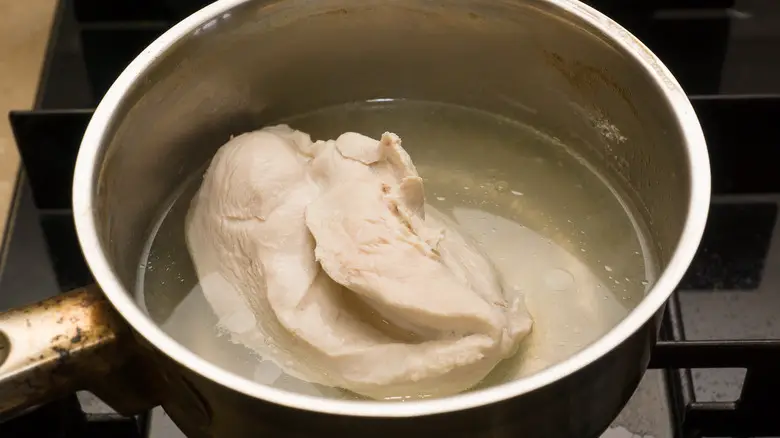Chicken broth, also known as chicken stock, is a flavorful liquid made by simmering chicken bones, meat trimmings, vegetables, and seasonings. It can be used as a base for soups, stews, casseroles and adds a rich flavor to other dishes like rice and quinoa. Many people are unaware that the leftover liquid from boiling chicken can be used to create delicious recipes instead of being discarded. This article will discuss what to do with chicken broth after boiling chicken.
Additionally, it’s important to minimize food waste by utilizing every part of an ingredient. Using the leftover broth is not only practical but also helps reduce unnecessary waste.
Benefits of Using Chicken Broth
Chicken broth boasts a range of nutritional benefits because it is made with animal protein that contains collagen and gelatin. These nutrients help support digestive health and overall immunity.
Moreover, using chicken broth in cooking makes meals more flavorful without adding extra fat or sodium. Additionally, its versatility expands the range of foods you can cook with. Here are some examples:
- Base for Soups: The most common use for broth is as a base in soup recipes like chicken noodle soup or lentil soup.
- Stews: Consider using broth in stews like beef stroganoff or lamb stew.
- Casseroles: When preparing baked dishes like lasagne or shepherd’s pie, add some broth to bring additional moisture and flavor.
- Grain-based Dishes: Rice pilaf and quinoa are perfect examples where adding some broth instead of water can take your dish to the next level.
How to Store Chicken Broth
Storage techniques differ depending on whether you’re dealing with homemade or store-bought broths.
Homemade:
The general rule when storing homemade broths is to keep them no longer than three days in the fridge. If you have excess amounts left over from your cooking session, consider freezing them for later use. A good way to do this is to pour the broth into ice cube trays to get the perfect portions. After they have completely frozen, transfer them into ziplock bags and label them with the date.
Another popular storage option is using glass jars or Tupperware containers. They are especially useful since you can see inside the container and measure out as much broth as you need for your recipe. Make sure the container has completely cooled down before tightly sealing it with a lid.
Store-bought:
Store-bought broths generally have a longer shelf life than homemade ones. Unopened cans or cartons of chicken broth can last up to six months in the pantry as long as there is no visible damage to packaging, such as rusting or swollen cartons.
Once opened, store-bought chicken broth lasts about five days in the refrigerator and six months in the freezer. Manufacturers usually list expiration dates on their products, which serve as a guide for freshness.
To freeze store-bought chicken broth, pour it into freezer bags and make sure there’s enough space left on top for expansion while freezing.
How to Use Chicken Broth in Cooking
A long list of recipes utilizes chicken broth as an essential ingredient; here are some ways you can use it:
Main course meals:
- Chicken Noodle Soup: The perfect comfort food made with boiled chicken, carrots, celery, onions, egg noodles cooked in a flavorful simmered stock.
- Curries: Infuse curry dishes with rich flavor by using some leftover liquid.
- Chili: Adding broth helps thicken chili sauce while giving it added depth in flavor.
Side dishes:
- Rice Pilaf: Swap water for broth when cooking rice pilaf to add an extra layer of flavor.
- Roasted Vegetables: Drizzle vegetables with some olive oil and sprinkle seasoned salt and pepper. After roasting quickly toss vegetables with a little bit of leftover gravy for an added zing.
Sauces and Gravies:
- Gravy: Transform regular gravy by using chicken broth instead of water. It makes a tastier liquid base that will make it a crowd-pleaser.
- Sauces: It’s great to use when preparing hearty meat dishes like beef bourguignon or pulled pork sandwiches. Dilute the sauce with some broth, and you will have a more robust, flavorful meal.
Homemade vs. Store-bought Broth
Making your own broth is often more flavorful, but it can be time-consuming since you need to prepare the ingredients and simmer them for hours. While store-bought broth is more convenient and requires less effort to prepare, it can sometimes contain flavor enhancers or other additives that aren’t present in homemade versions.
The nutritional value also differs; homemade broths tend to contain fewer additives, meaning they are typically higher in protein and minerals such as calcium.
Unless otherwise stated, most store-bought chicken broths are low-sodium versions. On the other hand, homemade versions could contain a higher sodium count if seasoned aggressively. Many health-conscious people prefer making their own broths since they control the salt content as per their preferences.
How to Make Your Own Chicken Broth
Creating your own chicken broth is simple, ensures quality control over ingredients and packs more flavor than any store-bought version just by following these steps:
Ingredients
- 3 lbs of chicken (bones, skin on or off)
- 8 cups of water
- 2 carrots chopped
- 2 ribs celery chopped
- 1 garlic head halved crosswise (optional)
- Thyme, peppercorns, bay leaf (all optional)
Procedure
- Place the bones into a large pot cover with water.
- Add vegetables and seasonings (garlic head & thyme/peppercorns/bay leaf) to the pot with a pinch of salt and bring to a boil, then reduce heat.
- Simmer over low heat for at least 1 hour until all ingredients are tender.
- Remove from heat and strain the mixture using a sieve or cheesecloth.
Once strained, let it cool on helping rack before storing in containers. Freeze it if not planning to use within the next few days.
Conclusion
Chicken broth is an underrated ingredient that can be utilized for so much than it’s cliched image as just being chicken noodle soup. It offers a range of nutritional benefits and packs in flavor without adding any extra fat or sodium. Storing homemade broth dictates that it should last for no longer than three days in the fridge but can be frozen and kept for future use, while store-bought versions usually last up to six months.
Homemade versions tend to be more flavorful with fewer additives and higher mineral content like calcium. Since chicken broth is versatile, many dishes could benefit from it, whether in main courses, side dishes or gravies enhancing taste buds’ experiences.
Making your chicken broth guarantees quality control over ingredients for health-conscious people seeking dietary-control options besides offering a sense of nostalgic home-cooked meals that boast surety of high-quality ingredients used previously discarded due to unawareness of their culinary uses.
So next time you boil some chicken, don’t throw away those bones and skin; make yourself some delicious homemade chicken broth!
Q&A
- Q: Can you save the liquid leftover from boiling chicken? A: Absolutely! The flavorful broth can be used in soups, stews, or even as a base for cooking rice or other grains.
- Q: Is it safe to drink the liquid after boiling chicken? A: While technically safe to consume, drinking this broth directly may not be everyone’s cup of tea. However, it is a great source of nutrients and can be easily incorporated into other dishes.
- Q: Do you have to discard the liquid if you’re using a store-bought rotisserie chicken? A: Since the meat has already been cooked through the rotisserie process, there isn’t as much flavor in the liquid compared to traditionally boiled chicken. However, it can still be saved and used for cooking if desired.
- Q: How do you store leftover chicken broth? A: Allow the broth to cool down before transferring it into an airtight container and refrigerating or freezing it. It can safely be stored in the refrigerator for up to 4 days and in the freezer for up to 6 months.






